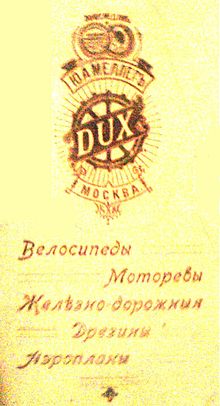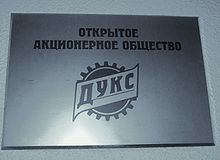- Dux Factory
-
Dux (also known as Duks or Dooks) was a bicycle/automobile/aircraft factory in Moscow, Russia before and during World War I. The factory was founded in 1893. The name comes from the latin word dux (leader). Y. A. Meller was owner of the factory which was primarily focused on the building of French aircraft designs. The factory is still active at its original location and returned to its original name several years ago. However, the company is now focused on air-to-air missile production and some aircraft sub-components. The aircraft production arm was separated from the factory in the early 1920s; it is also active at its original location at the Central Moscow airfield and is named RAC MIG Production Complex #2 or the P.A. Voronin Production Center. Over the years it has also been known as OSOAVIAKHIM Plant #1, GAZ No. 1, Menjinski Plant #39, Orjonikidze Plant #381, Plant #30, MMZ (Moscow Machine-Building Plant) "Znamya Truda" (Banner of Labor), and "Moscow Aircraft Production Organization (MAPO) named after Dementiev" (Petr Dementiev, Minister of Aircraft Industry from 1953 to 1977).
Contents
Pre-WWI Aircraft
The majority of types built by Dux were French and other Western aircraft designs. The first aircraft made was a licensed Farman IV with ENV engine, which made its first flight on August 18, 1910. From there, in addition to copies, some improvements were designed for existing models. The first of these was a Farman VII in 1912 with some improvements that were put into production. A more ambitious project was the Dux Meller I which combined a Bleriot main fuselage with a Farman XV nacelle added, all driven by a 100 hp Gnome-Rhone in pusher configuration. A modified Farman XVI was later produced under the name Dux Meller II and flown in 1913. The following Dux Meller III was a failed attempt to produce a single-engine twin-propeller chain-driven monoplane. Further work went into the Dux No 2 but this was also a failure. While engineering continued on a new twin engine pusher, in the end the factory's primary activity was construction of Western designs.
Summary of aircraft built by Dux Model name First flight Number built Type Dux Meller I Dux Meller II 1913 Dux Meller III Dux No 2 WWI Aircraft
Dux produced Voisin LAS, Nieuport 17, Nieuport 24, Farman family of aircraft including models IV, VII, XVI, XXX, as well as a large number of military bicycles.
1920s and '30s
After the October Revolution the plant was named "Aircraft plant #1 named after OSOAVIAKHIM" or "GAZ No. 1". Farmans and Nieuports were left in production. Polikarpov became the chief designer in the late 1920s. Production models included I-5, I-15, I-15bis, I-153, I-16, R-5, and R-Zet aircraft.
Second World War
Plant #1 produced the MiG-3 before evacuation in October 1941. Plant #39 produced the DB-3F before evacuation in October 1941. After production recovery, Plant #30 produced the IL-2, and Plant #381 produced the La-5 and later the La7.
Post-war period
Plant #381 produced the Il-12, a small series of I-250, and the first 75 of MiG-15. In 1949 and 1950 two neighboring plants were united into Plant #30. The production of Il-28 began. After this the following aircraft were produced: Su-9, Yak-25, Il-14, Il-18 with modifications, MiG-21, and MiG-23.
21st century
The MiG-29 was put in production. Civil programs include MiG-AT, T-101, T-411, and Aviatika MAI-890 aircraft.
Successors
The Dux factory gave the origin to many production institutions, among which are some world-wide recognized firms.[citation needed]
References
- Gunston, Bill (1995). The Osprey Encyclopedia of Russian Aircraft From 1875 to 1995. Osprey. pp. 2. ISBN 1 85532 405 9.
See also
Categories:- Aircraft manufacturers of Russia
Wikimedia Foundation. 2010.


